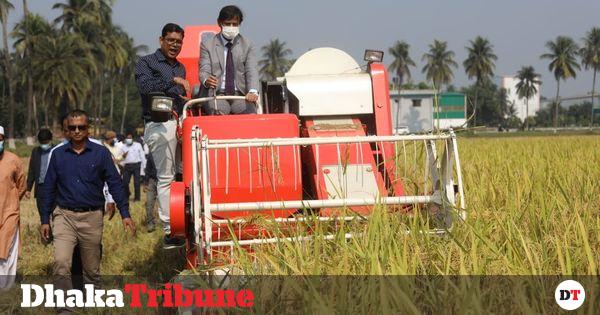[ad_1]
Bangladesh’s first locally made combine harvester, designed and manufactured by Bangladesh Rice Research Institute and Janata Engineering, is being field tested at a BADC farm in Chuadanga Courtesy
Local manufacturers say they can export surplus after meeting local demands if govt provides policy, funding supports
Bangladesh on Friday successfully field tested its first-ever locally manufactured full-fledged combine harvester rekindling hope to substantially reduce its import dependency for agricultural machineries.
Bangladesh Rice Research Institute (BRRI) and Janata Engineering jointly designed and manufactured the combine harvester, capable of reaping, threshing, gathering, winnowing and packing paddy right on the fields in quick time.
The combine cuts up to 70 percent of costs the farmers have to, otherwise bear, for accomplishing the same tasks manually.
The modern combine harvester, or simply combine, is a versatile machine designed to efficiently harvest a variety of grain crops. The name derives from its combining a number of separate harvesting operations — reaping, threshing, gathering, winnowing, packing — into a single process. Combine harvesters are one of the most economically important labour-saving inventions, significantly reducing the fraction of the population engaged in agriculture.
Under the government-provided farm mechanization subsidy program, Bangladeshi farmers bought 2,300 farm implements in last financial year, and 1,762 of them were combine harvesters. But all of the combines were imported, costly and farmers still had to bear a substantial cost to manage 50 percent matching fund upon getting the other half as government subsidy.
Also Read – Debunking Bangladesh’s rice import paradox
Government has a plan to help farmers procure as many as 50,000 farm machines by 2025 under the current farm mechanization subsidy program but high costs of imported combines remain a big concern as farmers can ill-afford the matching fund.
Both BRRI and Janata Engineering now hope if they get necessary policy support and financial support from the government, Bangladesh can manufacture the combines at much cheaper price, meet domestic demand and also export abroad.
They say the successful manufacturing of the one unit that was pressed into operation on a trial run on Friday is a clear demonstration of Bangladesh’s capacity to manufacture world-class combines.
Customized to well suit Bangladesh’s fragmented tilling lands and muddy rural roads of Haor region, the BRRI-Janata built combine is more efficient in terms of its maneuvering capacity, and comparable to any of the imported ones when it comes to its crop harvesting efficiency.
The next step

Md Ole Ullah founded Janata Engineering in Chuadanga back in 1992 and steered it through many odds over the last three decades, finally earning for his farm machinery manufacturing unit an ISO standard and Bangabandhu Agriculture Award last year.
Ullah told Dhaka Tribune yesterday that Janata had been trying to develop a locally built combine since 2015 and had some success already by 2019 but thanks to BRRI supports and collaboration that since January this year together they worked hard to finally build a full-fledged combine harvester, which can reap and process paddy of each acre of paddy field in just one hour.
Janata Engineering’s Managing Director Md Ole Ullah has firm conviction that if the government diverts even a third of its over Tk. 3,000 crore farm mechanization subsidy to finance the farm implement manufacturers, they would be able to procure capital machineries, build modern manufacturing unit and start commercially produce the combines meeting not only the local demands but also export some surplus.
Also Read – Bangladesh develops best hi-zinc rice yet
Ullah, also an executive body member of the farm implement manufacturers association, said he is also in favour of resource-pooling and manufacturing combines in collaborative manners by multiple manufacturers together.
BRRI Director General Dr Shahjahan Kabir was present, among others, to witness the field trial of the combine held on Friday at Bangladesh Agricultural Development Corporation’s (BADC) farm in Noornagar, Chuadanga.
Dr AKM Saiful Islam, who heads the ‘Strengthening Farm Machinery Research Activity for Mechanized Rice Cultivation Project’ and serves as a Principal Scientific Officer at BRRI, spearheaded the combine harvester manufacturing initiative.
He told Dhaka Tribune on Saturday: “We field tested it on Friday and got a very good result. It’s efficient and has a comparative advantage over the imported ones when it comes to adapt to Bangladesh’s fragmented tilling plots.”
“The one we developed has a cutting width of 1.5 metre and can move freely in small land areas, the percentage of grain damage is hardly one percent while unthreshed grain percentage is also less than one percent,” added Dr Saiful.
Both Ole Ullah and Saiful said in a rough estimate that once manufactured in bulk commercially, the combine will cost somewhere in between Tk. 16 lakh to 20 lakh.
Currently, some of the combines that are being imported from China and sold here cost in the range of Tk. 28 to 30 lakh and farmers have to bear half the price even after government provided subsidy covers the remaining half.
[ad_2]
Source link








